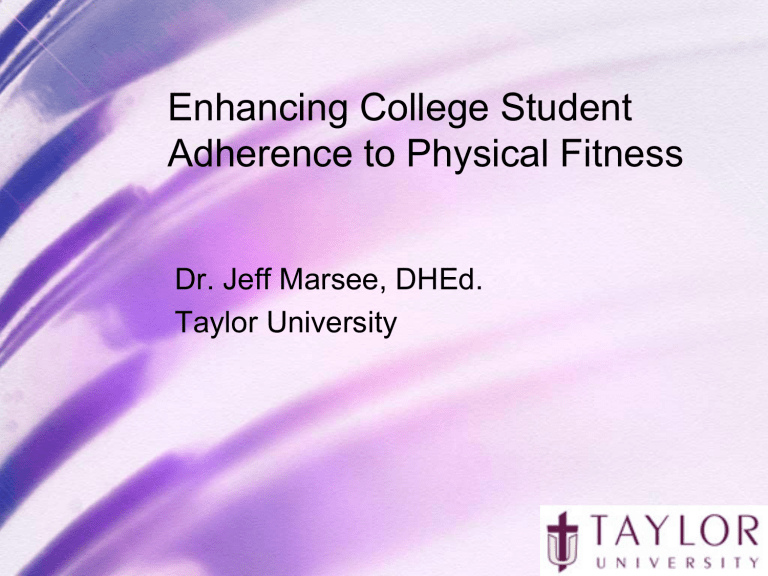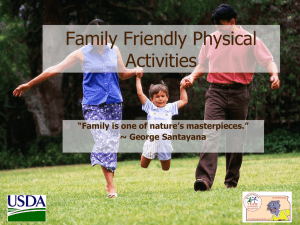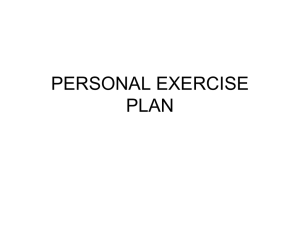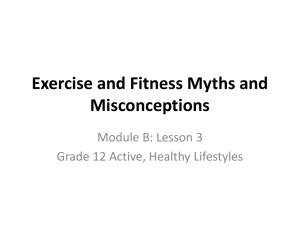Document

Enhancing College Student
Adherence to Physical Fitness
Dr. Jeff Marsee, DHEd.
Taylor University
Who Are Our Students?
Some come to us with a positive attitude toward physical activity.
Others may have been active off and on through their developmental years.
Yet others, have adopted a lifestyle that rarely exercises, engages in on-line activities, and does not focus on healthy eating patterns.
The “Transitionalists”
• Numerous personal, social, and environmental reasons are reported why the “transitionalists” do not participate in enough physical activity.
• The transitional period could itself be a barrier because of the changing roles and responsibilities of the young person. Most frequently reported barriers include lack of time, lack of interest, and lack of energy (Gyurcsik, Bray, & Brittain, 2004).
Unique to the College Student
• Physical activity becomes less of a priority in one’s life and unhealthy lifestyle behaviors are acquired.
This time is critical for the adoption and maintenance of exercise behaviors that will linger through the lifetime (Sullum, Clark, and King, 2000).
• Fitness and wellness knowledge does increase with completion of a required lifetime fitness course by college students (McCormick and Lockwood, 2006)
• Total weekly activity minutes and habitual leisuretime activities decrease by 31% during this transitional time (Van Mechelen, Twisk, Post, Snel,
& Kemper, 2000)
• A conceptual physical education course, in which key concepts are addressed rather that fitness alone, has been found to reverse the downward trend of physical activity during this time (Jenkins,
2006)
• Adopting healthy lifestyles during the first two years of college could help prevent weight gain and potentially some level of obesity later in life (Hallal,
Victoria, Azevedo, & Wells, 2007).
Statement of the Problem
• Only 24% of adults over 18 years of age participate regularly in moderate physical activity and 25% are sedentary (Buckworth, Granello, &
Belmore, 2002).
• As most students decrease their activity levels after they leave high school, the risks become greater as the traditional college students continue consuming high caloric levels, maintain high stress levels, function on fewer hours of sleep, and may participate in other high risk activities. Most studies have identified barriers that students perceive limit or prevent them from participating in physical activity.
Barriers for the college student
• Five types of barriers are thought to exist in a college community setting (McLeroy, et al 1988).
• Intrapersonal
• Interpersonal
• Institutional
• Community
• Public Policy
• Physical (Gyurcsik, et al., 2004)
Investigated Course
• PHP100 – Fitness for Life (1 hr)*
• 15 weeks in length
• Taught by numerous PHP faculty and adjuncts.
• About 250 students take the course each semester.
• Pre and post fitness testing is done but that is likely to change. The 1.5 mi run is also done in class pre and post. Optional blood work is also done.
• Three distinct units are found in the course: fitness, nutrition, and personal health.
Learning Outcomes
1. Participants were expected to develop a personal philosophy of fitness and wellness.
2. Participants created personal exercise and nutritional programs.
3. Participants developed strategies in which they can increase adherence and compliance to a personal exercise program.
4. Participants were to develop an increased awareness of contemporary health issues, their prevention, treatment, and effects.
Course Objectives
1. Define and understand fundamental concepts of physical fitness, nutrition, and health.
2. Calculate and implement the results of physical fitness formulae on their own lifestyle.
3. Evaluate dietary habits and design a personal nutrition program.
4. Show improvement in cardiovascular endurance through regular aerobic exercise.
Objectives (cont’d)
5. Explain behavioral change strategies and selfmanagement skills as related to wellness.
6. Philosophically and Biblically justify their position concerning importance of and need for stewardship of the body.
Learning Goals
• To improve student perception of exercise and personal wellness
• To revisit previously learned material from the viewpoint of an adult
• To develop a life strategy of maintaining good health and wellness
Research Questions
1.
What is the student’s present fitness level and current level of participation in physical activity? This was done by comparing test results to ordinal data taken from the survey.
2. Does the declared academic major affect participation in physical activity? This comparison came from simple categorical data off the survey instrument.
3. Does the family fitness levels influence current fitness levels of the students? Two aspects of ordinal data reported on the survey were compared.
To a lesser extent…
4. What are the differences between the intervention group and control group on perceived value of exercise, current levels of exercise, and influencing factors? This data was taken from the survey instrument.
5. Does a curricular change increase student perceived levels of participation and adherence to an exercise program after the course is completed? This data came from a comparison of the pre and post test survey instrument.
Methods
One-Group Pretest-Posttest Design with Control was designed and the Rickel Exercise Value Instrument* was intended to:
• Identify students’ purpose for participating in physical activity.
• Identify importance of socialization with participation in physical activity.
• Identify perceived barriers and benefits to physical activity.
• Identify personal and family impact on physical activity.
• Determine if academic requirements have an impact.
• Identify impact of intrinsic values on physical activity.
*(administered at week 2 and 3 mos. after)
Descriptive Statistics for Sample Background Characteristics
F
Control
(n = 40)
%
Experimental
(n = 52)
F %
Gender
Male
Female
Status
Freshman
Sophomore
Junior
Senior
School
Undeclared
Natural Sciences
Humanities
Professional Studies
18
22
20
9
5
6
0
0
36
4
45.0
55.0
12.5
15.0
50.0
22.5
90.0
10.0
0.0
0.0
26
26
23
18
4
7
1
1
46
4
50.0
50.0
88.5
7.7
1.9
1.9
7.7
13.5
44.2
34.6
Total Sample
(N = 92)
F %
47.8
52.2
89.1
8.7
1.1
1.1
9.8
14.1
46.7
29.3
44
48
1
1
82
8
9
13
43
27
Descriptive Statistics for Step Test as a Function of Group
Note . Table includes only those 77 subjects with both pretest and posttest measurements of the step test.
M
Control
(n = 32)
SD
Experimental
(n = 45)
M SD
Total Sample
(N = 77)
M SD
Step Test Heart
Rate Pretest
Step Test Heart
Rate Posttest
39.28
9.91
36.69
5.28
37.73
8.86
38.38
8.24
36.96
6.89
36.84
6.24
Descriptive Statistics for Crunch Test as a Function of Group
Note . Table includes only those 79 subjects with both pretest and posttest measurements of the crunch test.
M
Control
(n = 33)
SD
Experimental
M
(n = 46)
SD
Total
Sample
(N = 79)
M SD
Crunch Test
Pretest
Crunch Test
Posttest
26.94
25.67
17.15
13.30
27.98
24.02
27.54
21.30
28.61
23.40
27.38
19.76
Correlations between Measures of Aerobic Fitness and Continued Participation
*p<.01
Step
Test
Crunch
Test
Continued
Participation
Pretest
Step Test
Crunch Test
Continued Participation
1.00
.01
-.01
1.00
.31* 1.00
Posttest
Step Test
Crunch Test
Continued Participation
1.00
-.10
-.28
1.00
.13
1.00
Results
• The first subproblem addressed in this study was:
Determine if present levels of fitness affect continuing participation in aerobic activity.
• Pretest step tests were not significantly correlated with continued participation while pretest crunch tests were positively correlated with continued participation in physical activity.
• Posttest results did not show a correlation with continued physical activity.
Activity Level by School Major at Pretest
Note . Table includes only those 82 individuals who completed the pretest.
Undeclared
(n=4)
Natural
Sciences
(n=12 )
Humanities
(n=40 )
Professional
Studies
(n=25 )
Total
Sample
(N=86) f % F % F % f % F %
Pretest
Non-
Exercisers
Exercisers
4 44.4
7 58.3
21 52.5
10 40.0
42 48.8
5 55.6
5 41.7
19 47.5
15 60.0
44 51.2
Activity Level by School Major at Posttest
Note . Table includes only those 50 individuals who completed the posttest.
Undeclared
(n=4)
Natural
Sciences
(n =9)
Humanities
(n=21 )
Professional
Studies
(n=16)
Total
Sample
(N=50) f % F % F % F % f %
Pretest
Non-
Exercisers
Exercisers
2 50.0
3 33.3
12 57.1
4 25.0
21 42.0
2 50.0
6 66.7
9 42.9
12 75.0
29 58.0
Results
• The second subproblem was: Determine if the declared academic major affects reported levels of aerobic activity.
• School majors were compared with the reported activity level in both the pre or post tests. Whether an individual regularly exercised or not did not depend upon a particular academic major. Improvement was made within each school.
Correlations between Measures of Aerobic Fitness and Family Exercise
Pretest
Family Exercise
Posttest
Family Exercise
Continued
Participation
-.08
.03
Results
• The third subproblem was: Examine reported family fitness levels and their effect on continuing participation in aerobic activity.
• Results from specific questions on the survey instrument were compared to continued participation in physical activity. No correlation was found between continued participation in physical activity and family fitness levels in either the pre or post tests.
Implications
• Current level of physical activity does not statistically influence continued physical activity. As educators, we should take advantage of this time which students are forming life-long habits and beliefs.
• Academic major does not negatively influence the physical activity levels of students. Students from all majors showed increase in their physical activity levels after the course.
• Family fitness levels did not influence continuation of physical activity in college. This can be important as more students are coming from sedentary backgrounds and family situations.
Recommendations for further study
• In her study, Rickel (2005) found the increased focus on written assignments helped to enrich subjective values and perceptions regarding the value of physical activity.
This revised course added significant journaling as part of the student assignments and allowed students to develop personal philosophy statements about wellness.
• Academic awards were not investigated in this study.
DeVahl, King, & Williamson (2005) found that these can help motivate students to engage in a voluntary exercise program.
• We have attempted to post fitness test results for participants so they can see where they fall in the population and possibly serve as an intrinsic motivator.
• When instructional modifications are suggested, professors can be either offended or threatened. Those who have taught the course the same way for many years will wonder why change is even needed.
• This study has shown moving from a lecture and media based method of presentation to an interactive and discussion type class, students appear to come more prepared and willing to share during the class.
• Assessment changes can lead to more time for class interaction and promote student-centered learning.
• Small group work was well-received and supported results in the literature.
• Chronic illness assignment had a noticeable impact on students even though it was not investigated.
Limitations
• Self-reporting nature of the data including self and familial fitness levels
• Small sample size but similar studies could be replicated on other campuses
• Instructional and motivational techniques
• Fitness routine variations between faculty (cardio only, cardio with strength, cardio with strength and flexibility)
Recommendations for Courses
1. Course modifications can be easily done causing increased adherence to a personal exercise program.
Curriculum mapping may help focus the content with numerous faculty or those less willing to change.
2. Changes in assessment methodology can help to increase student ownership of the topic.
3. Including strength and flexibility training in the 10-week exercise program will cause improvements in overall fitness levels rather than aerobic alone.
Recommendations (cont’d.)
4. More focus on collaborative work and personal reflection creates better discussion and class activities. Increased writing in the course leads to increased student understanding.
5. Introduction of the chronic illness project increases student awareness of the benefits for good nutrition and adequate physical activity.
6. Longitudinal studies should be used to determine change over the four years
Summative Assessment Techniques
Students will demonstrate knowledge and understanding through completion of the following forms of summative assessment:
1. Personal Philosophy of Fitness and Wellness papers
(affective).
2. Weekly reports during the 10-week exercise program
(psychomotor).
3. On-line chapter quizzes (cognitive).
4. Nutritional assessment (cognitive).
Formative Assessment Techniques
Formative feedback would occur with the following forms of assessment:
1. Collaborative unit projects (cognitive and affective).
2. Extensive personal journal (affective).
3. Chronic illness project (affective).
References
Buckworth, J., Granello, D. H., & Belmore, J. (2002). Incorporating personality assessment into counseling to help college students adopt and maintain exercise behaviors, Journal of College Counseling, 5(1), 15-25.
Devahl, J., King,R., & Williamson, J. W. (2005). Academic incentives for students can increase participation in and effectiveness of a physical activity program. Journal of American College Health 53(6), 295-298.
Gyurcsik, N. C., Spink, K. S., Bray, S. R., Chad, K., & Kwan, M. (2006). An ecologically based examination of barriers to physical activity in students from grade seven through first-year university. Journal of Adolescent
Health, 38(6), 704-711.
Hallal, P. C., Victoria, C. G., Azevedo, M. R., & Wells, C. K. (2006) Adolescent
Physical Activity and Health. Sports Medicine , 36(12 ), 1019-1030.
Jenkins, J. M. , Jenkins, P., Collums, A, & Werhonig, G. (2006) Student perceptions of a conceptual physical education activities course. Physical
Educator, 63(4), 210-221.
McCormick, J., & Lockwood, P. (2006). College student's perceptions of wellness concepts. Physical Educator, 63(2), 78-103.
McLeroy, K. R., Bibeau, D., Steckler, A., & Glanz, K. (1988). An ecological perspective on health promotion programs. Health Education Quarterly,
15(4), 351-377.
Rickel, K.F. (2005). Exercise adherence, a philosophical shift promoting a life narrative based curriculum and technology to augment commitment to exercise . Unpublished doctoral dissertation. University of Idaho, Moscow.
Sullum, J., Clark, M. M., & King, T. K. (2000). Predictors of exercise relapse in a college population. Journal of American College Health, 48(4), 175-180.
VanMechelen, W., Twisk, T. W. R., Post, G. B., Snel, J., & Kemper, H. C. G.
(1998). Physical activity of young people: the Amsterdam longitudinal growth and health study. Medicine and Science in Sports and Exercise, 32,
1610-1616.
Thank You
Jeff Marsee, DHEd, ATC
Department of PHP
Taylor University
Upland, IN 46989 jfmarsee@taylor.edu






